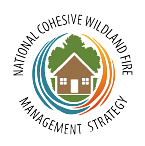Co-hosted by the Northern Rockies Fire Science Network and the Wildland Fire Cohesive Strategy Western Regional Strategy Committee, this field tour showcased success stories and lessons learned while addressing the National Cohesive Wildland Fire Management Strategy vision for the next century: to safely and effectively extinguish fire, when needed; use fire where allowable; manage our natural resources; and as a Nation, live with wildland fire. To achieve this vision, the Cohesive Strategy identifies three goals, which were part of field tour discussions and stops: 1) Resilient Landscapes, 2) Fire Adapted Communities, and 3) Safe and Effective Wildfire Response.
Featured partners on this field tour included the Forest Service, Bureau of Land Management, Confederated Salish and Kootenai Tribes, Montana Department of Natural Resources and Conservation, Missoula County Office of Emergency Services, Lolo Restoration Committee and the Blackfoot Challenge. The tour provided opportunities to hold in-depth discussions around managing fire in a complex landscape, and the need for cross-jurisdictional collaboration and communication before, during and after fire.
The tour began with stops in and around the Marshall Woods Restoration Project in the Rattlesnake National Recreation Area to discuss community mitigation and education on private lands; fuel treatments on public lands adjacent to a complex human landscape; and the Wildfire Adapted Missoula Project. For the second half of the day, the tour headed north to visit Confederated Salish and Kootenai Tribal lands; discussion topics included Traditional Knowledge about fire, Reserve Treaty Rights Lands program, and sharing resources across boundaries.
The Northern Rockies Fire Science Network partnered with the Western Region Cohesive Strategy Committee to host this field tour.
Relevant Resources
Related Documents from the Research and Publications Database
Event Details
Jun 20 2019, 8am - 5:30pm
Contact(s)
Vita Wright
406 396-5374
Monique Wynecoop
509 684-7091
